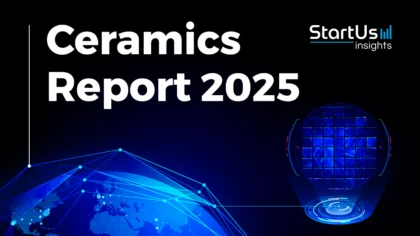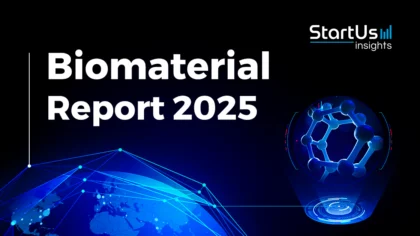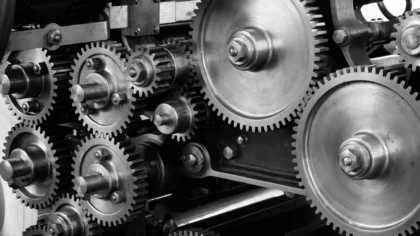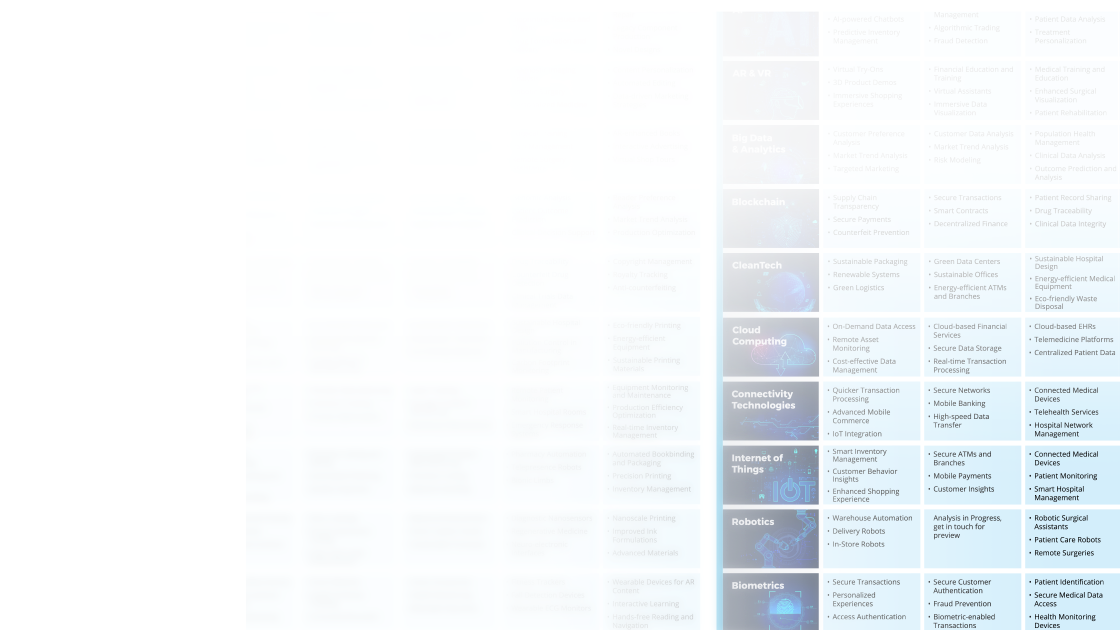The 2025 Ceramics Report explores the global market, examining growth dynamics, technological advancements, and emerging applications across various industries. As a versatile material, ceramics have gained importance in sectors from construction and automotive to healthcare, electronics, and renewable energy. The demand for advanced ceramics, known for their strength, heat resistance, and chemical stability, drives innovation and expands the market’s footprint.
The report highlights key trends, including bio-ceramics in medical applications, ceramic materials in 3D printing, and ceramics in energy-efficient technologies. It provides insights into investment patterns and emerging startups that are pushing the boundaries of ceramics technology.
This ceramics industry report serves as a reference for stakeholders within the industry, investors, policymakers, and economic analysts, providing a snapshot of the industry’s health to map its trajectory for innovation and growth in the coming years.
StartUs Insights Ceramics Report 2025
- Executive Summary
- Introduction to the Ceramics Report 2025
- What data is used in this Ceramics Report?
- Snapshot of the Global Ceramics Industry
- Funding Landscape in the Ceramics Industry
- Who is Investing in Ceramics Companies?
- Emerging Trends in the Ceramics Industry
- 5 Innovative Ceramics Startups
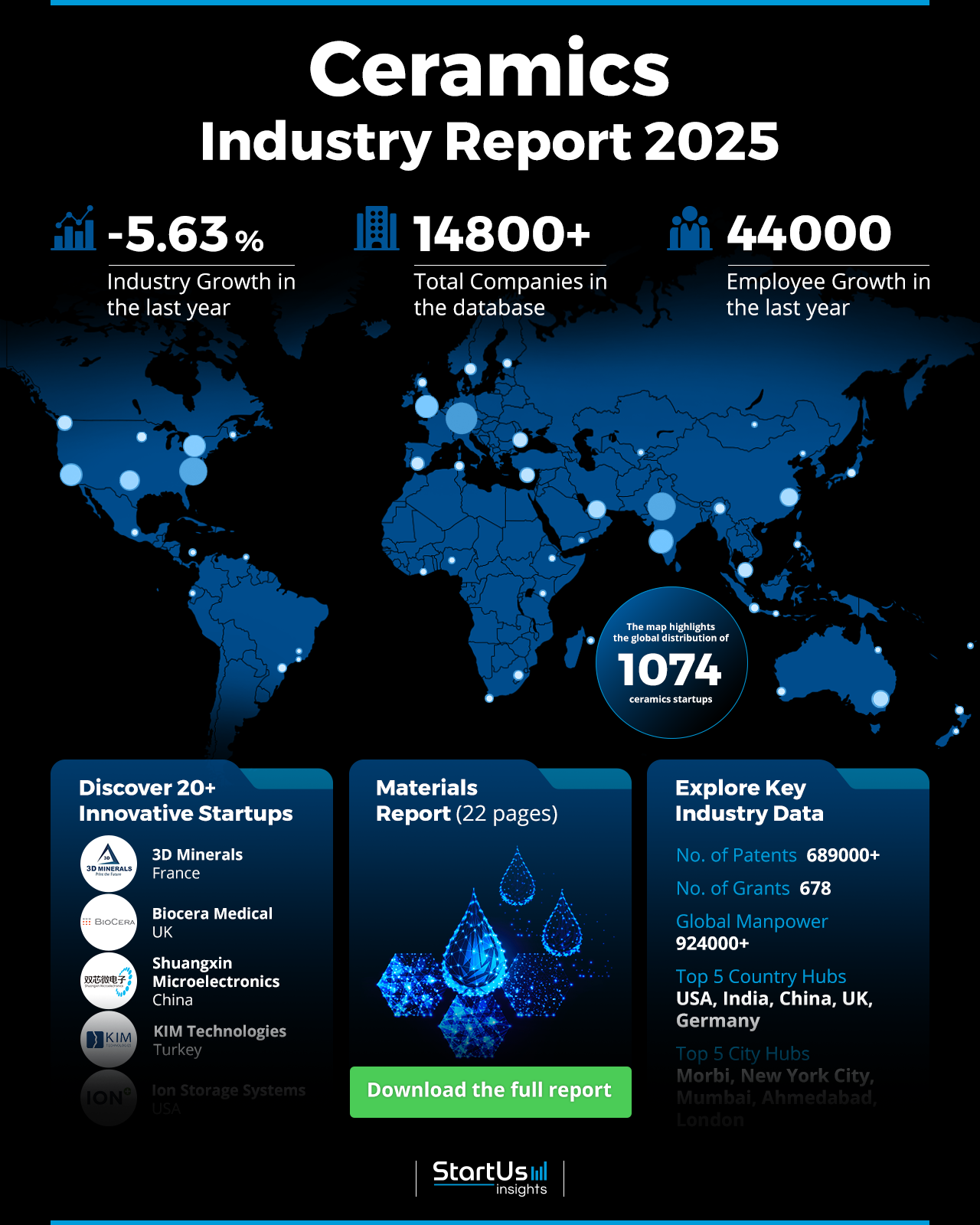
Executive Summary: Ceramics Market Report 2025
This report is created using data obtained from the Big Data and AI-powered StartUs Insights Discovery Platform, covering more than 4.7 million global companies, as well as 20K+ technologies and emerging trends. We also analyzed a sample of 1000+ ceramics startups developing innovative solutions to present five examples from emerging ceramics industry trends.
- Industry Growth Overview: The ceramics industry has over 14800 companies, including 1000+ startups. It faces a growth rate of -5.63%, indicating challenges in market expansion.
- Manpower & Employment Growth: The sector employs over 924K people globally, with 44K new employees added last year.
- Patents & Grants: The industry holds over 689000 patents filed by more than 188000 applicants. In addition, 670+ grants support innovation and research initiatives.
- Global Footprint: Key country hubs include the USA, India, China, the UK, and Germany. Leading city hubs for innovation are Morbi, New York City, Mumbai, Ahmedabad, and London.
- Investment Landscape: The ceramics industry has seen more than 1200 funding rounds, with an average investment of USD 18 million per round. The sector also attracted over 560 investors.
- Top Investors: Cleon Capital, Victoria, ZhenFund, and more have contributed to a combined investment value of over USD 160 million.
- Startup Ecosystem: Five innovative startups include 3D Minerals (Ceramic 3D Printing), Biocera Medical (Bioceramic Coatings), Shuangxin Microelectronics (Electronic Ceramic Components), KIM Technologies (Ceramic Matrix Composites), and Ion Storage Systems (Ceramic Solid Electrolyte).
- Recommendations for Stakeholders: Entrepreneurs and companies should focus on adopting advanced manufacturing technologies and sustainable practices to enhance productivity and reduce environmental impact. Embracing digital tools for design and distribution increases market reach. Investing in research and development to create high-quality, unique products will promote competitiveness.
Explore the Data-driven Ceramics Industry Report for 2025
The Ceramics Report 2025 uses data from the Discovery Platform and encapsulates the key metrics that underline the sector’s dynamic growth and innovation. Our database features 1074 startups and over 14800 companies working with ceramics globally. With a current annual growth rate of -5.63%, the sector remains dynamic. There are over 689000 patents and 678 grants, reflecting ongoing innovation.
The global manpower totals 924K, with an employee increase of 44K last year. The top five country hubs include the USA, India, China, the UK, and Germany which lead in ceramics production, while Morbi, New York City, Mumbai, Ahmedabad, and London are key city hubs for ceramic innovation.
What data is used to create this ceramics report?
Based on the data provided by our Discovery Platform, we observe that the ceramics industry ranks among the top 5% in the following categories relative to all 20K topics in our database. These categories provide a comprehensive overview of the industry’s key metrics and inform the short-term future direction of the industry.
- News Coverage & Publications: The ceramics industry generated over 10000 publications last year.
- Funding Rounds: Our database includes data from over 1200 funding rounds. This reflects investment activity and financial momentum.
- Manpower: With a global workforce of over 924000, the ceramics industry added 44000 new employees last year.
- Patents: The 689000 patents in the industry highlight a strong focus on innovation.
- Grants: A total of 678 grants have been awarded to companies in the ceramics industry. It supports various research and development projects.
- Yearly Global Search Growth: The industry experienced a 9.54% yearly global search growth, showing growing interest and visibility online.
A Snapshot of the Global Ceramics Industry
The ceramics industry faces a negative annual growth rate of -5.56% due to market expansion challenges. However, it is expected to rebound and grow, driven by increasing demand in construction, sustainability initiatives, and advancements in ceramic applications across healthcare and electronics. The sector also includes 1074 startups, with 167 in the early stages and 621 involved in mergers and acquisitions. The industry holds over 689000 patents filed by more than 188000 applicants, with a yearly patent growth of 0.36%. Leading patent issuers are the USA (165,000), China (99,000), and Japan (82,000).
Explore the Funding Landscape of the Ceramics Industry
Investment activity remains strong, with an average investment value of USD 18 million per round. The ceramics sector has attracted over 560 investors, with 1200 funding rounds closed and more than 500 companies receiving investment. These figures highlight the industry’s resilience and continued focus on development.
Who is Investing in Ceramics Companies?
Top investors in the ceramics industry have collectively invested over USD 160 million, demonstrating strong financial backing for innovation and growth.
- Cleon Capital has invested USD 95.2 million across 2 companies.
- Victoria has invested USD 28.5 million into 3 companies.
- ZhenFund has contributed USD 19 million, investing in 2 companies.
- Forerunner Ventures has allocated USD 13 million to 2 companies.
- Topps Tiles has invested USD 11.2 million into 2 companies.
- BDC Venture Capital has invested USD 3 million in 2 companies.
Access Top Ceramics Innovations & Trends with the Discovery Platform
The ceramics industry is experiencing dynamic changes, driven by several emerging trends that are shaping its future. Here are a few emerging ones along with the firmographic insights:
- Additive Manufacturing, with over 17500 companies using 3D printing, grows at 21.62% annually. This trend demands precision, customization, and efficient production. With 855K employees and 56K new jobs added last year, 3D printing transforms traditional ceramics processes.
- The Printed Circuit Board (PCB) trend, though slightly declining at -0.03%, remains crucial in electronics. Over 4400 companies employ 454K people in this sector, with an addition of 19K in the last year. This shows ceramics’ increasing role in electronic devices.
- Biomaterials, growing at 13.45% annually, drive sustainability and innovation, especially in healthcare. Over 1850 companies and 85K employees push the boundaries of ceramics by creating eco-friendly and biologically compatible solutions across industries. This trend has seen an addition of 7K+ employees in the last year.
5 Top Examples from 1000+ Innovative Ceramics Startups
The five innovative startups showcased below are picked based on data including the trend they operate within and their relevance, founding year, funding status, and more. Book a demo to find promising startups, emerging trends, or industry data specific to your company’s needs and objectives.
3D Minerals specializes in Ceramic 3D Printing
French startup 3D Minerals develops ceramic 3D printers, including the Cartesian 3D Printer, 3D Printer with Rotary Table, and Robotic Ceramic 3D Printer, all using its patented slurry deposition modeling (SDM) technology. This process allows continuous 3D printing of large ceramic parts by combining slurry and additives just before extrusion to ensure efficient production. The startup’s technology lets businesses adjust the firmness of the ceramic paste during printing to optimize for different applications and materials. It offers benefits such as precise control over paste properties, scalability for large parts, and the ability to avoid air bubbles, reducing defects. 3D Minerals’ solutions offer customizable systems for producing complex ceramic components across technical and traditional industries.
Biocera Medical develops Medical Implants Bioceramic Coatings
UK startup Biocera Medical creates bioceramic coatings for medical implants using its electrochemical oxidation (ECO) technology. This process converts metal surfaces like magnesium, titanium, and zirconium into functional ceramic layers. The startup’s technology embeds selected elements into the growing oxide layer to enhance osseointegration, corrosion resistance, and antibacterial properties. Its benefits include reduced healing times, prevention of metal leaching, and improved mechanical durability. Biocera Medical’s coatings are useful for dental and orthopedic implants to control magnesium implant resorption rates and prevent infection. These solutions improve patient outcomes and reduce healthcare costs by minimizing implant rejection and complications.
Shuangxin Microelectronics manufactures Ceramic Electronic Components
Chinese startup Shuangxin Microelectronics develops electronic ceramic components, including low-temperature co-fired ceramic (LTCC) and high-temperature co-fired ceramic (HTCC) circuit. The startup uses multilayer technology with up to 50 layers to integrate ceramic materials and semiconductor packaging. LTCC circuits offer compact, low-loss solutions for high-frequency applications, and HTCC circuits perform well in extreme environments. These products are durable, miniaturized, and manage thermal efficiency effectively. Shuangxin Microelectronics’ components have applications in communication devices, automotive electronics, and industrial systems.
KIM Technologies creates Ceramic Matrix Composites
Turkish startup KIM Technologies develops ceramic matrix composites (CMCs) for aerospace, defense, and automotive applications. Its C/C and C/SiC materials replace metals in components like aircraft and automobile brake discs to provide heat resistance, abrasion protection, and lower specific gravity. These materials withstand extreme conditions to ensure durability and performance. KIM Technologies uses its proprietary manufacturing processes to deliver solutions that enhance safety, efficiency, and performance, offering a lightweight yet robust alternative to traditional materials.
Ion Storage Systems produces Ceramic Solid Electrolyte
US startup Ion Storage Systems develops solid-state lithium metal batteries with a ceramic-based electrolyte structure. This design uses nonflammable ceramic materials as a separator between battery layers to improve safety and prevent dendrite growth. The ceramic framework supports the lithium metal anode to create uniform pathways for ion flow, which enhances energy density and power efficiency. The startup’s technology offers faster charging times, eliminates compression systems, and is compatible with various cathode types. Ion Storage Systems provides safer, energy-dense, and versatile batteries for industries like electric vehicles, grid storage, and aerospace.
Gain Comprehensive Insights into Ceramics Trends, Startups, or Technologies
In 2025, the ceramics industry faces challenges and opportunities, with innovation driving growth in additive manufacturing and biomaterials. Despite slow overall growth, emerging trends in 3D printing and sustainable materials transform the industry’s future. Continued investment and technological advancements will be crucial as the sector evolves to meet changing market demands and sustainability goals. Get in touch to explore all 1000+ startups and scaleups, as well as all industry trends impacting ceramics companies.


